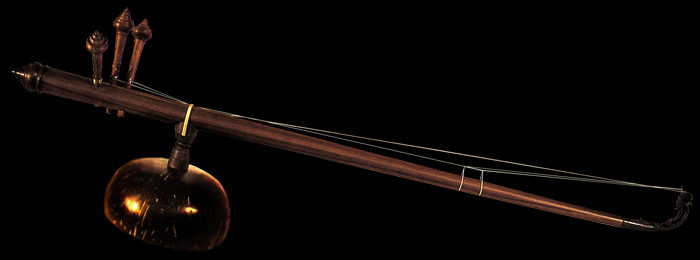Pin Pia
The pin pia is a stick zither played by the Lanna people of the Chiang Mai region of Northern Thailand. The instrument traditionally had two strings but now three and four string versions are quite common. The strings start at the tuning pegs and then run under a cord that is wrapped around the stick body to hold the coconut resonator in place. The strings then run the length of the body and run over a metal elephant head shaped tailpiece, which they are also attached to. The main melody string is made of brass and the accompaniment string or strings are usually steel. A small tuning thread is loosely tied between the body and the accompaniment string or strings to facilitate a higher pitch, and slid along the body to fine tune.
The left hand holds the instrument with the thumb under the resonator, while fretting the melody string, and occasionally picking the open accompaniment string. The right hand holds the body of the instrument with the thumb, while plucking with the third finger and fretting harmonics with the first knuckle of the first finger. The instrument is played primarily in harmonics. It is an extremely difficult instrument to play as the harmonic positions played by the right hand change as the left hand frets the string. It has an extremely quiet, haunting sound.
The pin pia is related to the Cambodian one-string satdiev or khse diev, which is probably older. Both instruments derive from early Indian vinas often pictured played by the goddess Sarasvati.
Country: Thailand
Region: Asia
Type: stick zither
|


